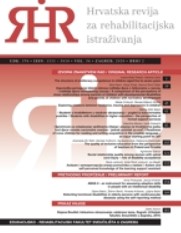THE STRUCTURE OF PRELITERACY COMPETENCE IN CHILDREN AGED FIVE TO SEVEN YEARS
THE STRUCTURE OF PRELITERACY COMPETENCE IN CHILDREN AGED FIVE TO SEVEN YEARS
Author(s): Ivanka Bider Petelin, Martina OzbičSubject(s): Phonetics / Phonology, Preschool education, Educational Psychology, Cognitive Psychology, Developmental Psychology
Published by: Sveučilište u Zagrebu, Edukacijsko-rehabilitacijski fakultet
Keywords: preliteracy competence; latent structure of preliteracy competence; early intervention;
Summary/Abstract: Children´s early literacy development is a key contributor to later literacy skills and overall academic achievement. We have developed a set of tests that assesses preliteracy competence based on well established foreign and Slovenian instruments or tools. A sample of 307 children aged from five to seven years were tested. A high Cronbach alpha coefficient (alpha = 0.87) indicates that the design instrument is an internally reliable instrument. This paper showcases and describes the differences in the development of preliteracy competence in different age group. The results show that children between 5 and 7 show the greatest development of the abilities to discern the initial sound, to analyze the sound, to notice the removal of sounds or syllables from a meaningless word, and to recall words on a given phoneme. Exploratory factor analysis with oblimin rotation revealed that preliteracy competence is best understood as a four-dimensional construct among children aged five to seven years. The first dimension is defined by higher-level phonological awareness, verbal memory, and rapid automatic naming, so it is metaphonology. The second factor, named perceptual language structure, expresses macro-linguistic structure (syllable, rhymes) and discrimination of words that sound similar. The third factor, named vocabulary, is saturated mostly by syllable analysis, vocabulary and word comprehension. The fourth factor is visual processing and capturing, which enable storage and refreshing of non-verbal information and the discrimination of symbols. The differences in development of preliteracy competency indicate intervention in the following areas: phonological awareness, verbal short-term memory, visual processing (discrimination and short-term memory) and vocabulary knowledge.
Journal: Hrvatska revija za rehabilitacijska istraživanja
- Issue Year: 56/2020
- Issue No: 2
- Page Range: 1-18
- Page Count: 18
- Language: English

